The reader may have encountered Anastácia before in some form. Her face, hidden beneath a gruesome iron mask, has become an icon of the horrors of slavery. Even outside of Brazil, her visage has appeared on protest posters, and her likeness was borrowed for a flashback scene in Jonathan Demme’s 1998 adaptation of Toni Morrison’s Beloved.1 What Anastácia signifies in Brazil, the country from which her legend comes, is complicated.2 Today, Anastácia is increasingly legible as a figure of resistance, and it is as a figure of resistance that I want to read her, asking whether a particular shrine to her that I visited last summer can be thought of as a monument to slave resistance.3 More than this, I am interested in Anastácia’s mutability, a saint-martyr-rebel-heroine who cannot be nailed down to one meaning, or even one place. Juxtaposing one of Anastácia’s fixed physical shrines to the moveable monument created by artist Yhuri Cruz, this diptych involves multiple dichotomies: fixed/fluid, material/immaterial, historical/fictional; divine/human; subjugation/resistance; enslaved/free.
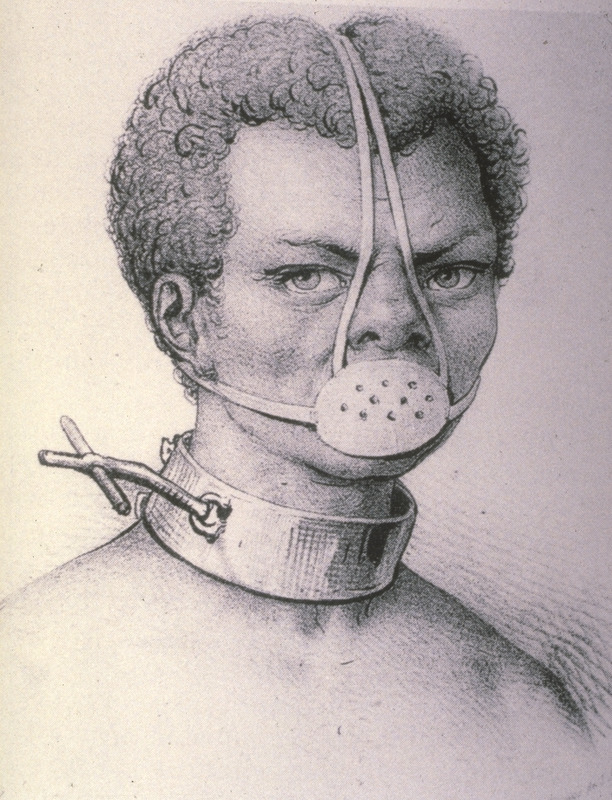
Bust of Anastácia first published in Jacques Arago’s 1839 Souvenirs d’un Aveugle, “Chatiment des Esclaves, Bresil.” Public domain. SlaveryImages.org. Image provided by the author.
I would be remiss if I didn’t note two things at the outset: First, many historians doubt whether Anastácia actually lived.4 Second, “Saint Anastácia” was not always embraced by the Black community as a symbol of racial uplift. The larger history of how a folkloric tale of a long-suffering enslaved woman came to be connected with the image we now associate with her, and thereafter transformed into a cultural icon, is beyond the purview of this short article. Instead, I am interested in contemporary commemoration of Anastácia as a symbol of empowerment.5 In place of the traditional historian’s reliance upon the written archive for validation, I value the oral archive preserved in the cultural memory of the descendants of the enslaved. As Marcus Wood reminds the reader in Black Milk, “How [Anastácia] appeared to the African slaves who came across her is not now possible to prove…”6 Our inability to “prove” Anastácia’s importance via written documents doesn’t invalidate her importance. The question of historical veracity (or better said, the undocumentability) of Anastácia’s tale is not an impediment to her legibility as an icon. Indeed, I want to argue that the untethered nature of Anastácia’s narrative, unmoored to any one ur-text and flexible in its significations, is actually conducive to her monumentalization as a figure of resistance.7
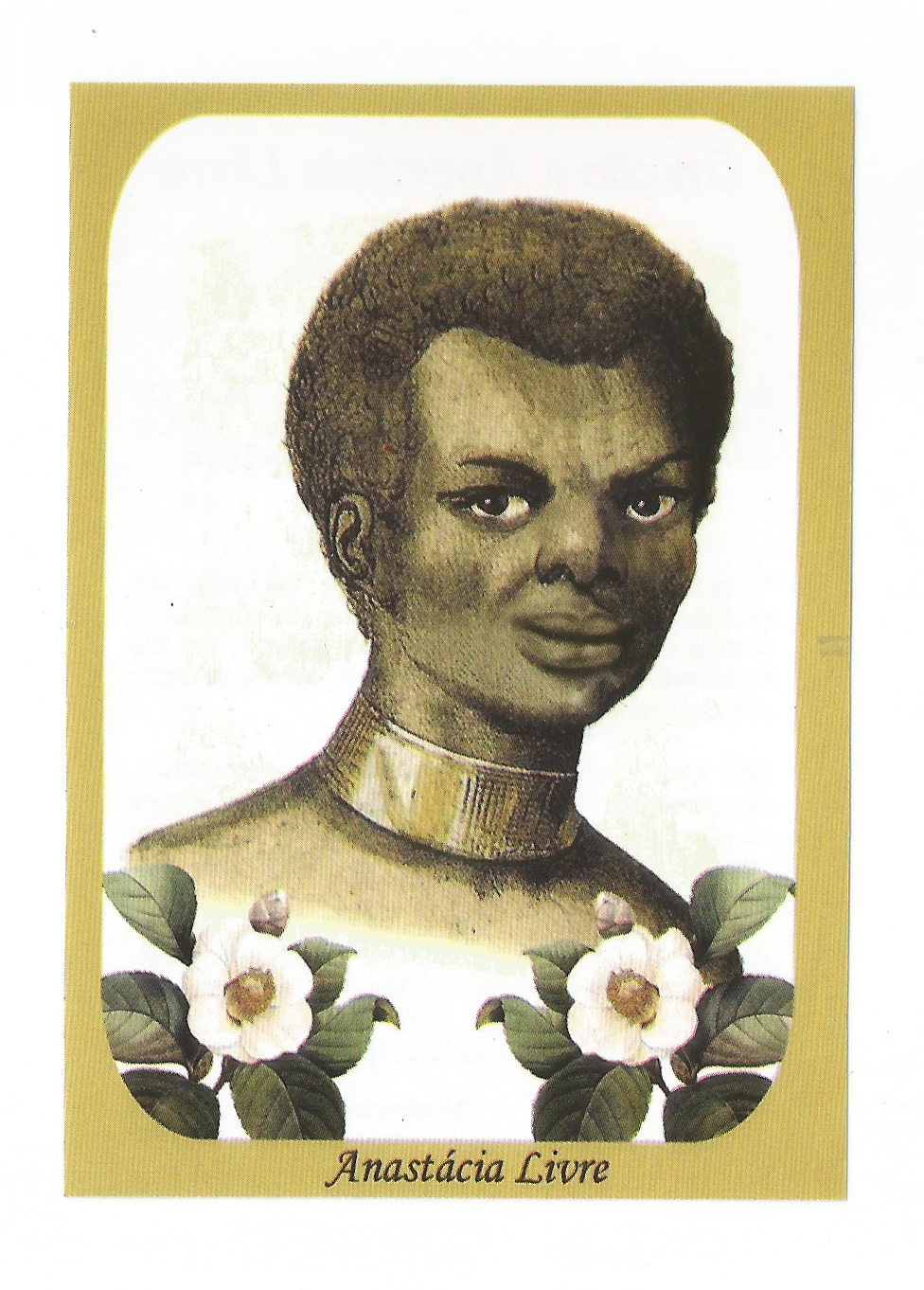
Yhuri Cruz’s Anastácia Livre from the installation Monument to the Voice of Anastácia, 2019. Image provided by the author.
The Mutability of Anastácia
Part of the complexity of Anastácia is her mutability: she existed first in an oral tradition belonging to enslaved persons, one that was not captured in the written archive until it was written down in 1971 (eighty-three years after abolition) by Yolando Guerra, “an amateur historian of slavery.”8 Anastácia’s narrative has changed over time, shaped by the proliferation of versions of her life, which includes two iterations dictated separately by spiritualists claiming to be in communication with the ancestral spirit (Maria Salomé and Nilton da Silva), a 1985 radio drama authored by Marizete Kuhn, and an overwhelmingly popular three-part miniseries that aired in 1990, produced by Manchete Television Network.9
Various versions of Anastácia’s life circulate in popular consciousness. Some of them are wildly divergent oral histories, and others are obviously shaped by the radio drama or the miniseries. That Anastácia came to have blue eyes, for example, is part of her evolving narrative, though this detail isn’t present in either illustration above.10 Anastácia is alternately comprehended as African royalty and dark-skinned, or mixed race and Brazilian-born, the product of a slave master. In some tellings, she is punished for her own beauty; or for the master’s love of her mother; or for her own relationship with the master by his wife, whether that relation is consensual or not; or for stealing some sugar cane to eat; or for resisting her own rape; or for directly inspiring a mass exodus of slaves from the plantation. Some associate her directly with causing a slave rebellion (if only inspiring it with her gaze).11
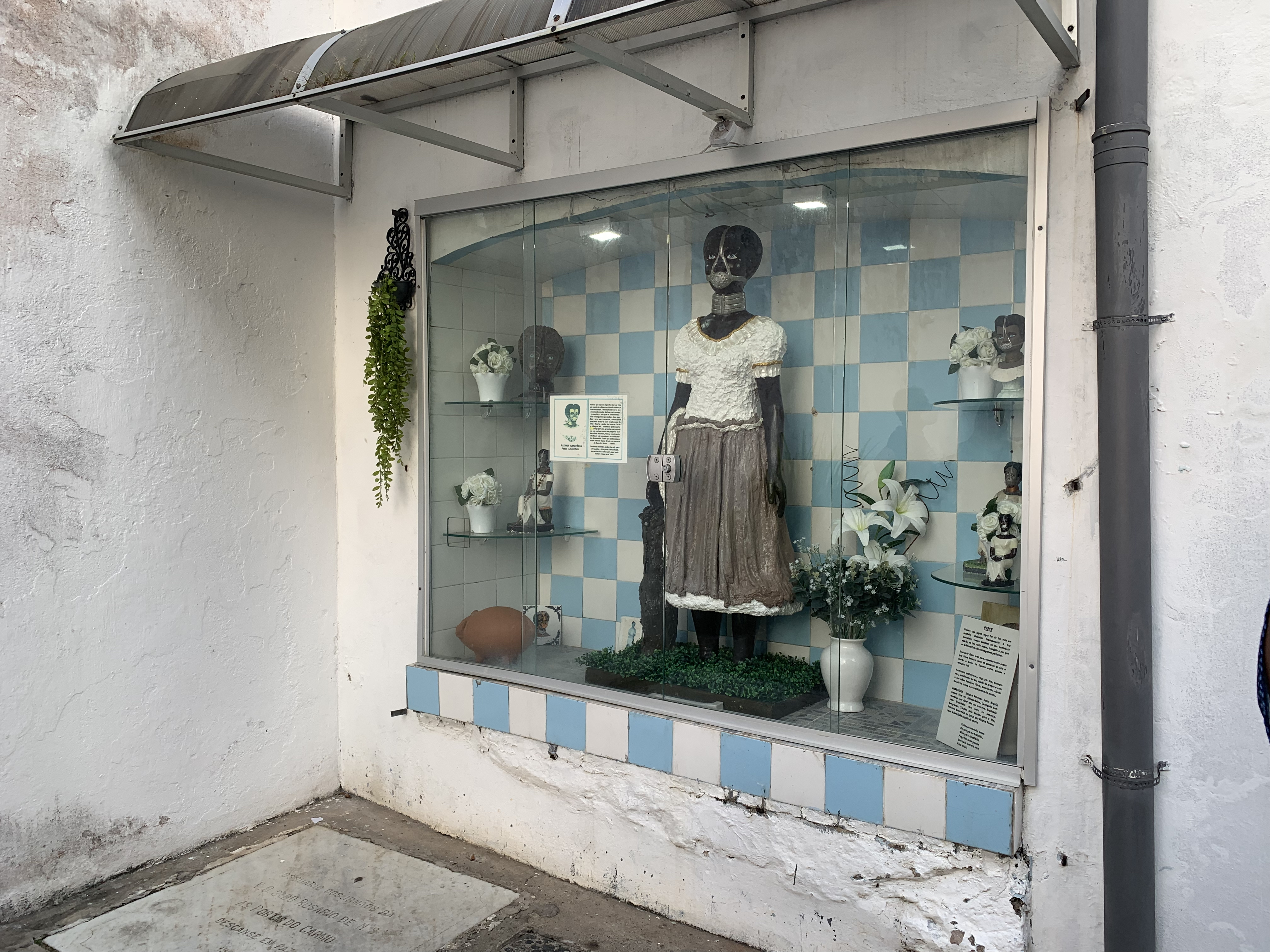
Suffice it to say here that Anastácia has meant different things to different people: As early as 1988, her likeness was included in a march against racism.12 But many find her image a depressing reminder of slavery’s cruelties, and a prominent version of the legend associated with this saint—of a martyr who forgave and saved the white children of her master even as she was dying—an unsatisfying figure of resistance.13 Some read her metonymic placement as an adjacent (but not canonized) Catholic saint as syncretic, an acknowledgement of the power of Candomblé; others understand Anastácia purely as a preto velho, an ancestral spirit in the Umbanda tradition.14
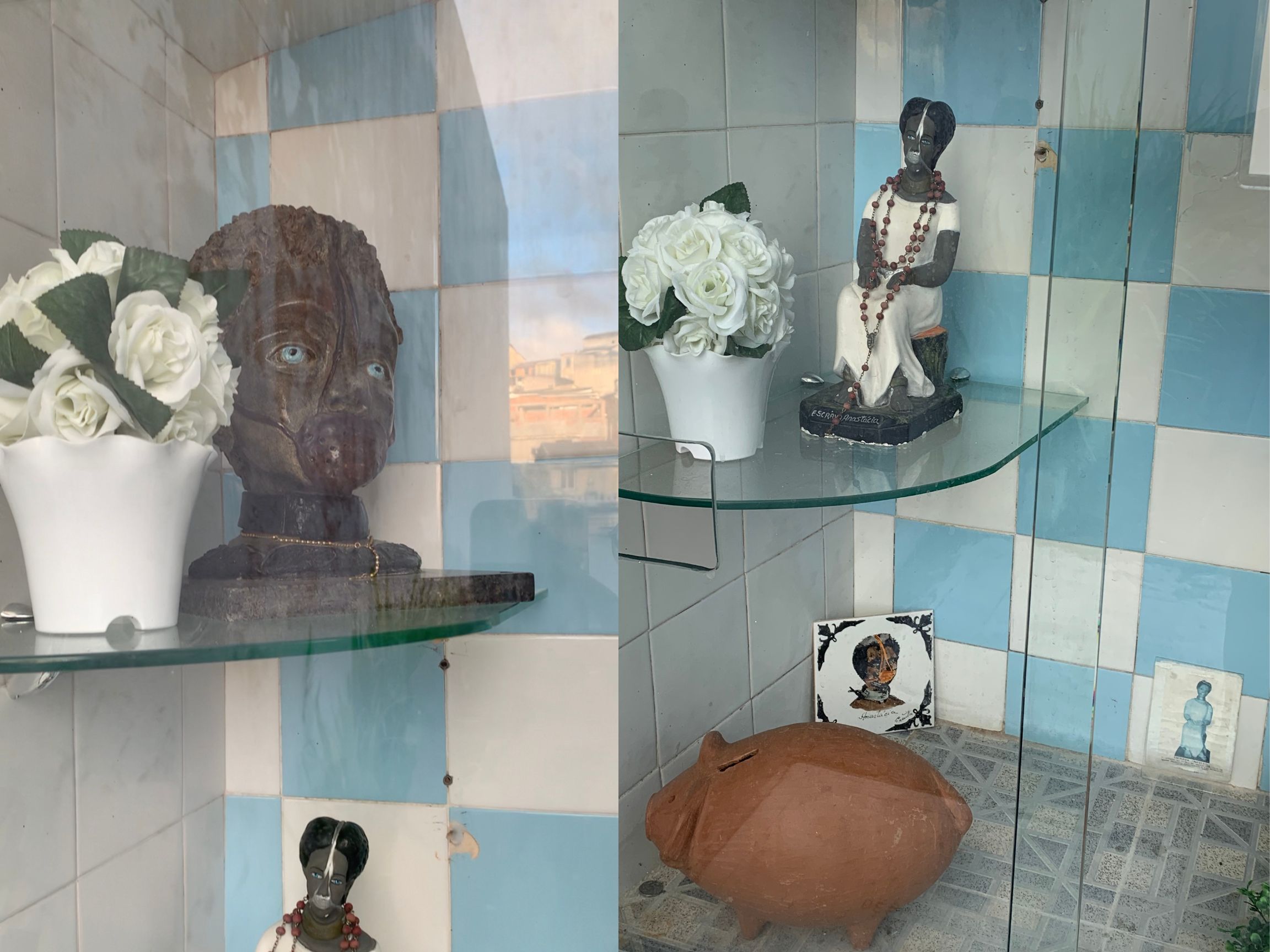
The shrine at the Igreja Rosario dos Pretos in Salvador makes visible Anastácia’s multiplicity, her mutability, her rootlessness as an oral tradition without a fixed, written ur-text. Located outside the church, on a wall of the back garden (presumably because of the Catholic Church’s refusal to officially canonize the saint), there is a large glass case set into the wall, consisting of blue and white tiles. In it are various figures of Anastácia: a nearly life-sized statue stands in the middle, of a dark-skinned Black woman with piercing blue eyes above the metal mask and neck collar, wearing the traditional Bahian dress of a white blouse with full skirt; she is flanked by several other versions of Anastácia set on shelves: including paintings on tiles inspired by Arago’s portrait to various degrees, sculptures of just her head, miniature statues of the enslaved woman’s full form, and traditional busts. None of these Anastácias are particularly light skinned, it seems worth noting, though Anastacia’s appearance varies in the blueness of her eyes, the fullness of her figure, the exact shape of her mask, her hair, her dress. Although Anastácia is anchored here in space, set behind glass and under cover of a small roof for rain, I want to suggest that, as a figure simultaneously understood as a saint/spiritual ancestor and historical figure of slave resistance, she is legible primarily as a moveable monument. To my mind the inclusion of various forms of Anastácia in this shrine references the prolixity of her narratives, her plurality, her ambiguity and unboundedness.
A Moveable Monument
To this, I want to juxtapose Yhuri Cruz’s 2019 art piece, Monumento à voz de Anastácia [Monument to the voice of Anastasia] a monument not only to Anastacia’s voice, but I would argue, to the meaning making we de around slave resistance. I first encountered this piece at the expansive art galleries at Inhotim, in Minas Gerais, a nature preserve which has “700 works by more than 60 artists coming from nearly 40 different countries…” But aptly, it wasn’t on the walls that I encountered the work, but on a T-shirt of a young woman, an artist named Yedda Affini, whom I randomly encountered in front of a gallery devoted to the important Brazilian artist, dramatist, and activist, Abdias do Nascimento. I recognized immediately that the image on this woman’s shirt was of Anastácia, despite the fact that she had been liberated of her mask. Affini was kind enough to give me the name of the artist, to let me take a picture of her in the T-shirt, to tell me a bit about the art piece, and to show me the prayer card, which she had stuck in her phone case.
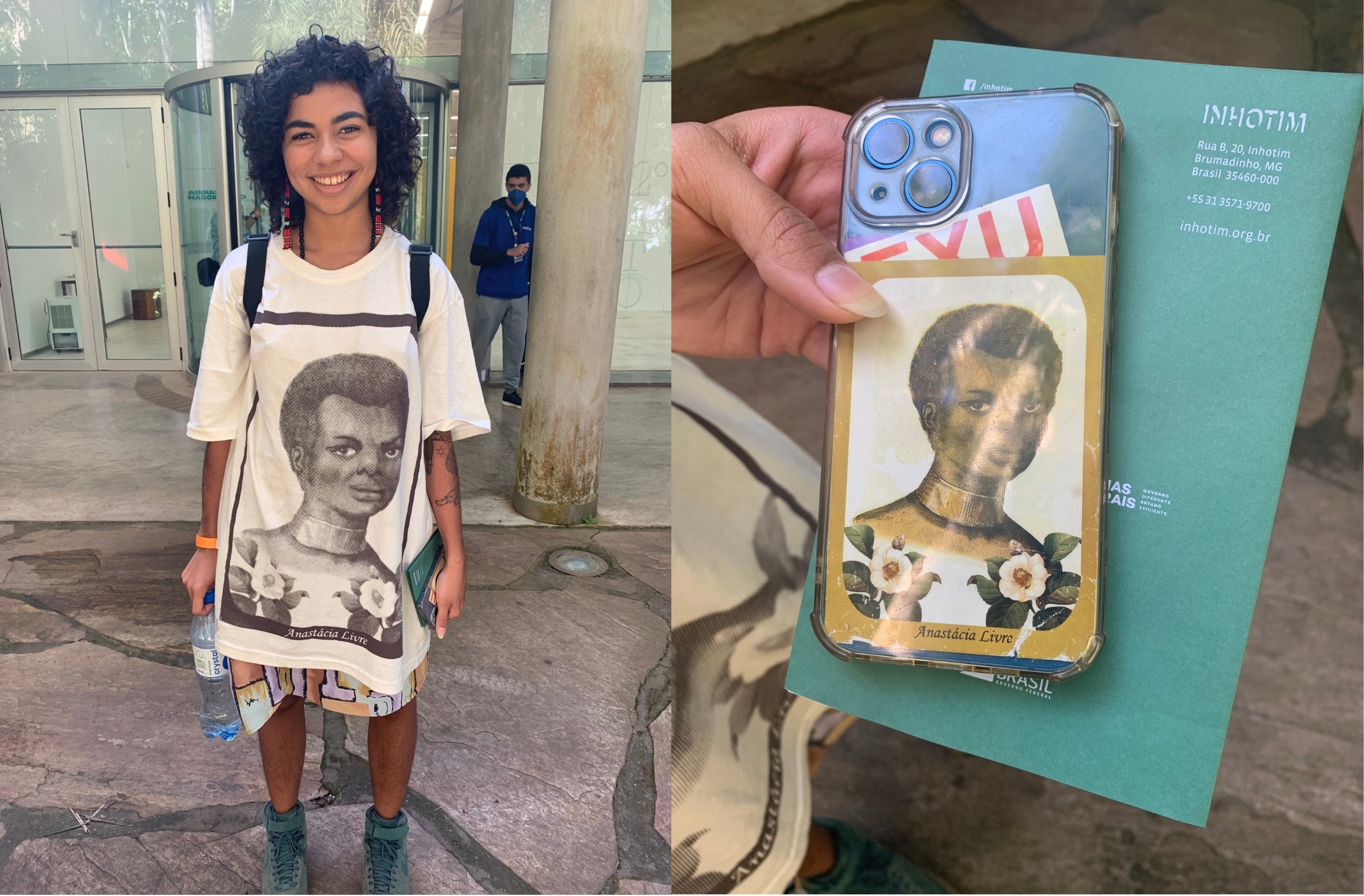
This was my first encounter with Cruz’s update of Anastácia. On Affini, she was a moving monument, one I felt lucky to encounter. Cruz pays homage to the legacy of Anastácia as inherently itinerant in his piece, taking the form as it does, of a portable prayer card, or as with Affini, worn for all to see on the front of a shirt.
The circulation of Escrava Anastácia is a longstanding part of her working. As Burdick notes of the sainted slave martyr, “Anastácia seems at first glance to be nowhere; but in fact she is everywhere. Her image is present in the form of prayer cards inserted into wallets; of medallions stuffed underneath shirts; of lockets kept in glove compartments; of prayer ribbons tied to rearview mirrors…”15 Cruz referenced this historical circulation of prayer cards in his 2019 installation of the work presented “in the exhibition Bodies-cities, in the Pence space (Rio de Janeiro, Brazil).”16 With a large-scale framed image of Cruz’s portrait of Anastácia Livre and to the side, a small cache of prayer cards hanging in a box mounted on the wall from which visitors could take one to carry away, Anastácia was materially doubled in this display, in the large, fixed frame and in small, portable formats.17 The doubling of the versions here, fixed and moveable, is just one dichotomy among many.
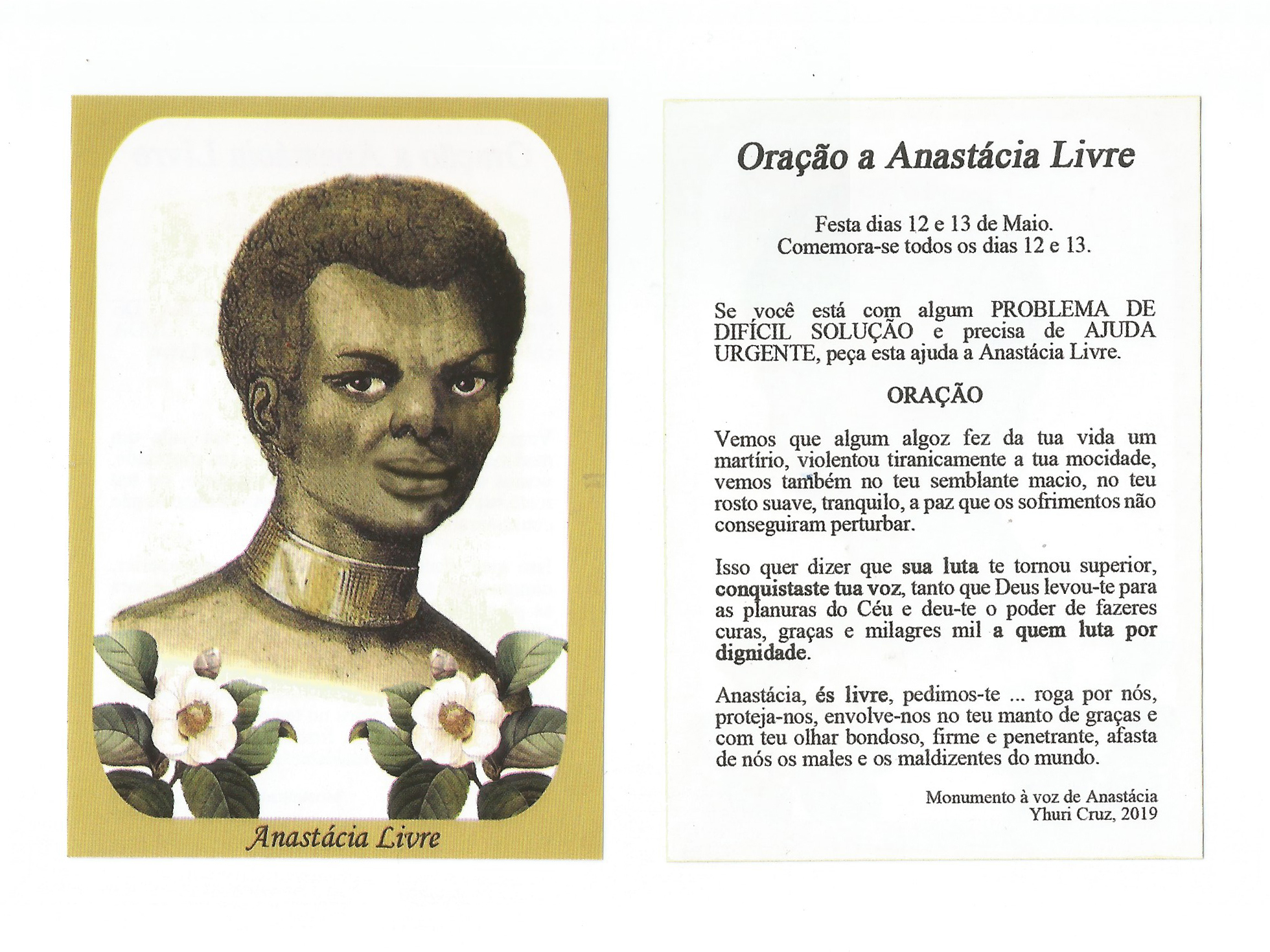
Front and back of Yhuri Cruz’s Anastácia Livre prayer card. Image provided by the author.
On the front of Cruz’s prayer card is a portrait of Anastácia that is meant to be understood as an unveiling of the recognizable image by Arago: perhaps her gaze is just slightly softened; the uncovered lips suggest contentment— it is almost a smile. The links on her neck collar have been removed, transforming the yoke into an adornment. The iconic tool of discipline, sometimes called the Flanders mask, also known as the dirt-eating mask, which was formerly affixed to her face so tightly that it indented the top of her hair, no longer obstructs the view of her visage, and her hair has returned to its natural shape. Magnolia blooms underline the image. Her eyes appear brown and not blue; perhaps they are even darker than in the Arago portrait. On the back of the card is Cruz’s updated prayer to Anastácia Livre, of which I’ll just provide a few lines here:
Anastácia, és livre, pedimos te … roga por nós, proteja-nós, envolve-nós, no teu manto de graças, e com teu olhar bondoso, firme e penetrate, afasta de nós os males e os maldizentes do mundo.
Anastácia, you are free, we ask you to pray for us, protect us, wrap us in your mantle of grace, and with your kind, firm, and penetrating gaze, drive away from us the evils and evil-doers of the world.18
Despite Cruz’s liberation of Anastácia, her suffering is still emphasized in this version, and there are no overt references to rebellion or resistance, even in the full prayer.
The work is described by Aldones Nino in the article “Between Silence and Healing: Folds in Time and Contemporary Art,” but the title of the work itself makes explicit the monumental work that the piece does. Nino reads Cruz’s art object as a “dialectical image” folding together past and present, in an important doubling.19 As Nino states, we recognize this as an image of Anastácia that simultaneously conjures its antecedent. Wood wrote of the original that when looking at Anastácia, the viewer “must confront first and foremost the fact that slavery gave white people an unrestricted access to the abuse of [B]lack bodies.”20 In some sense, then, even to see Anastácia unmasked, free, is to be reminded of the horrors of slavery.
I understand Nino’s point that Cruz’s Anastácia is a dialectical image: the portrait of Anastácia masked is so legible that even to see her unmasked is in some sense to have a kind of parallax vision: the viewer flashes upon the alternate version; and thus, this figure of resistance remains rooted in the history of oppression. This duality is at the heart of the difficulty with creating monuments to slave resistance: how do we celebrate something that shouldn’t have had to occur in the first place? My sense is that Cruz’s Monument to the Voice of Anastácia recognizes this limitation: importantly, in this visual form, her voice is still not heard.
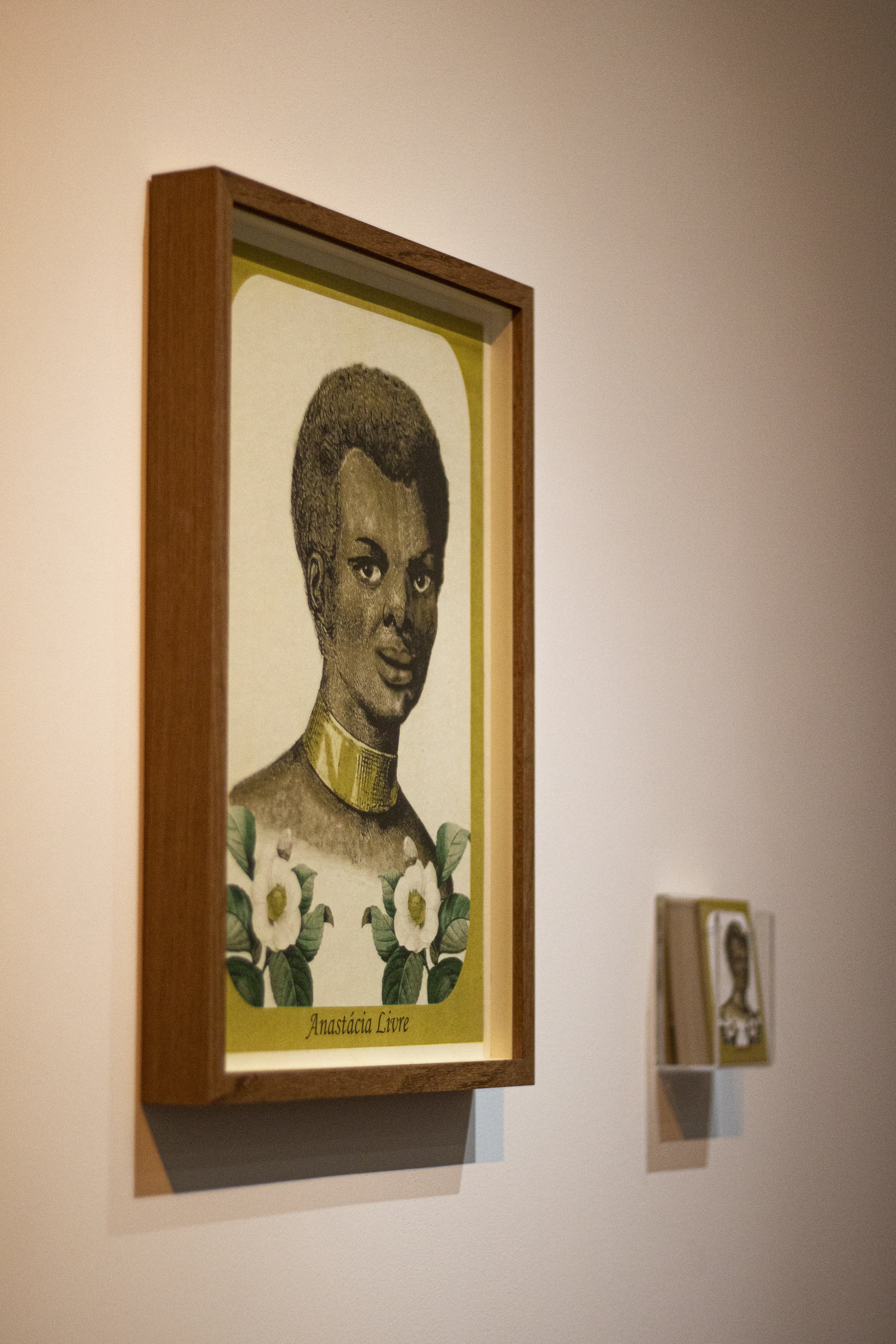
Yhuri Cruz, Monument to the Voice of Anastácia, installation, 2019. Photograph by Ana Luzes. Image provided by the author.
Subjugation or Resistance?
The doubleness of the Cruz portrait points backward to the inherent duality of the original.21 This is not the first time, it is worth emphasizing, that Anastácia has been liberated of her mask.22 References to a statue of her “in a simple smock without her mask, although still wearing a neck iron” is catalogued as a part of the Escrava Anastácia exhibit at the Museo do Negro, in a photo dating from 2008.23 In 1988, organizers debated whether or not to remove her mask before including her likeness in a parade for racial justice.24 Still, I find that the original version, mask on, is inherently a portrait of subversion as much as oppression. Here is a deceptively simple question that I ask my students, when asking them to contemplate Arago’s sketch, titled Chatiment des Esclaves, Bresil [The punishment of slaves, Brazil]: Is this a portrait of subjugation or of resistance?
One of my favorite versions of her life is Schwartz-Bart’s entry on Anastácia, related in the second volume of In Praise of Black Women, which depicts her as a woman who carried a message from the Yoruba water deity Yemanja to the enslaved, urging them to flee the plantation for a nearby quilombo, a community of maroon slaves living free in a community they defended against invasion. In this narrative, Anastácia was fitted with the iron mask to keep her from inciting more enslaved persons to seek their own liberty, but the sight of her eyes continued to inspire dissent, and she was sold to Rio, where she died in a dungeon. There is no story of a miraculous cure of the master’s children or forgiveness in this iteration. Instead, the narrative ends with a description of the shrine to Anastácia in the Igreja do Rosario in Rio, quoting from “a small pamphlet [that] circulates, …includ[ing] the text of all the prayers one can address to the Saint…” and citing “their most common and powerful prayer”:
Anastacia, holy Anastacia,
You who were borne by Yemanja, our mother,
Give us the strength to struggle each day
So we may never become slaves,
So that, like you, we may be rebellious creatures
May it be so. Amen.25
It’s tempting to end here, with an assertion that Anastácia’s diverse monuments, many of them mobile rather than fixed, are inherently invocations to become “rebellious creatures” (Axé!), but it is not that simple, and there is more left to say.
As Wood wrote in 2013, six years before Cruz’s installation, “Anastácia is magnificently unstable, growing, changing, proliferating, and going about her protean transmutations even as I write.”26 Anastácia had become increasingly associated with Black women’s liberation movements, a phenomenon that may have started with the all-female carnival drumming group Banda DiDá’s adoption of Anastácia’s iron mask as a part of their costume.27 I want to suggest that her unboundedness, her refusal to be only one thing— either a testament to the patience of the long-suffering enslaved person or a radical figure encouraging overt slave revolt; either a “mulatta” or pure African; either a saint or an ancestral spirit— is a part of her rebellion. Ambiguity can be a resistive strategy, as when, in the syncretistic practices that merged African religions with the imposed Christian framework, enslaved persons could make of St. Peter the Yoruba deity Ogun. Even the original portrait that came to be associated with Anastácia, her features hidden behind the disciplinary tool of the iron mask, is simultaneously a portrait of resistance.
Wood writes that “Anastácia stands as an extreme example of how the syncretic religions of Afro-Brazil can construct their own slavery inheritance, can by sheer force of imagination and intensity of memory make a new archive, and new symbols, that are realistic, idealistic, melodramatic, mundane, magical, practical, horrific, and inspirational at one and the same instant.”28 That a portrait of an enslaved person, their face clasped in a hideous instrument (likely to prevent them from eating dirt to combat malnutrition) could be read subversively is a monument—if not to any one documentable historical person, then at least to the apparatus of syncretism whereby significations were smuggled—in a benign word, in an image of a saint, in the fluid motions of dance—right under the master’s nose. Anastácia is a monument to the way survival, in all of its iterations (physical, spiritual, intellectual), was an act of resistance and, doubly, to the way that seemingly harmless things, like an image of a subjugated slave martyr, could hide a celebration of the enslaved’s rebellion.
In sum, I am saying that we didn’t need Yhuri Cruz to unmask Anastácia for her to be free; his doubling of her makes clear what was already a part of the cultural operations working within the image and its circulation in space. That Cruz’s work, in its form as a printed prayer card, harkens back to the original’s refusal to be anchored to one place underlines that the original, as well as itself, is contemplatable as a moveable monument. Burdick said that Anastácia is simultaneously everywhere and nowhere.29 Wood writes in Black Milk, “The slavery museum is all around you, if you have eyes to see it.”30 Taking a cue from Katherine McKittrick’s work on the “Black sense of place,” which was historically shaped by enforced rootedness to the plantation, I want to highlight Anastácia’s itinerancy as worthy of more scholarly attention: perhaps monuments to slave resistance should be unfixed in space, in deference to those who were not allowed to leave the master’s property.31 Regardless, Anastácia (protean, itinerant, unlocatable in the historical record, and at times decisively ambiguous) defies the taxonomic order that would reduce her to any one category: “saint,” “slave,” “rebel,” “martyr.” She must always be seen in double vision.
